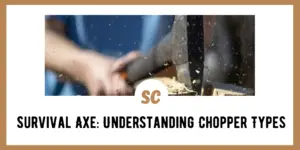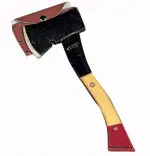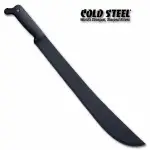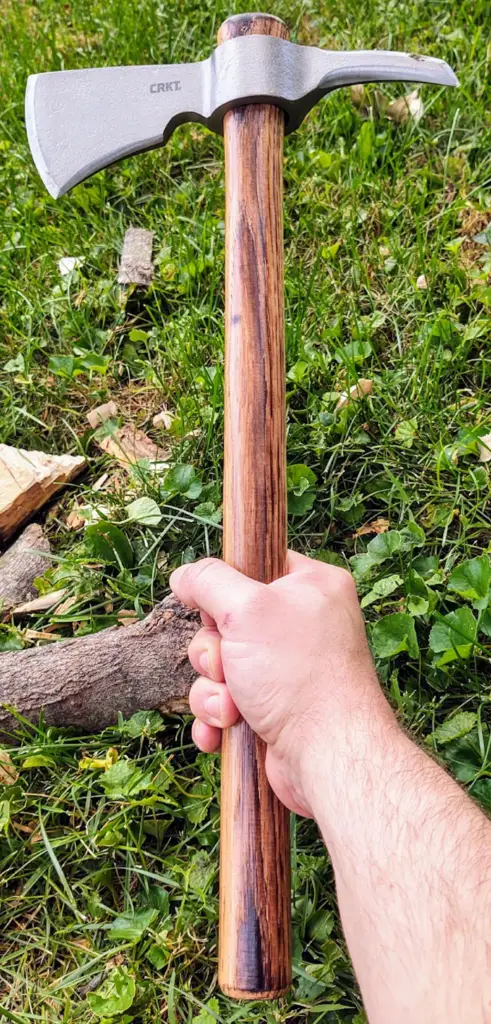As far as blades go in your survival gear there are three basic functions covered by a variety of tools.
The first is to puncture, slice, and cut, the second is to saw, and now we’ll cover the third in a brief outline of the best choices for survival chopping. When you have to drop a tree with your survival axe for some serious firewood you need the right tool.
SKIP AHEAD
What Makes Up An Axe?
There are two different parts of the axe that you need to be able to recognize in order for you to be able to select a quality axe that will last you a lifetime.
Axe Features
Handle
Originally made out of a straight-grained piece of hickory, many people now prefer the new metal or fiberglass handles on the market.
The handle of an axe is specially shaped for directing the force of your chop on the ax head. (We like the Gerber Camp Axe – tested it and it works)
Axe Head
The head is the part that bites into the wood. Some of the best axe heads are made out of one piece of forged steel, securely fastened to the handle.
Some axes such as those made by the Estwing® ax company, are made out of one piece of metal with a comfortable rubber grip attached to the metal handle. An axe can have a high-carbon steel head or one made from stainless steel.
A carbon steel head will require a little more maintenance, but they do work very well with a ferrocerium rod.
Types of Axes
There are a variety of different axes for different jobs. Here are some of the most common types.
Hatchet
Hatchet, camp axe, tomahawk whatever you wish to call it, has the same basic makeup.
It has a 1 to 1 ½ pound head on a 10 to 14-inch handle. It is great for limbing, and it is also the perfect size to split wood or kindling for a fire. It can easily be carried to the campsite or stowed in your Bug Out Bag for making emergency shelters.
The key feature of a hatchet is that it is small but versatile enough to be used in almost any small-scale outdoor scenario.
Pros
- Lightweight and short handle length makes it compact
- Will save space in your bag or vehicle
- Can be used for game processing (chop bone)
- Great for backpacking and camping trips
- Affordable
- Can be used by a wider range of individuals
- Opposite end of the axe head can be used as a hammer for things like tent stakes
Cons
- Great for small tasks but not so much for larger projects
- Short overall length
- Not meant for big trees
Forest Axe
The forest, boys, or range ax as it’s often called, is the jack of all trades of axes. The Council Tool Boy’s Axe is a good example.
With a head weighing between 2 and 2 ¾ pounds, and a handle between 18 and 26 inches in length, it is the perfect mix between the convenient size of the hatchet, and the weight of the felling axe.
Pros
- Good middle ground tool for most tasks
- Longer overall length
- Lightweight
- Packable
- Can tackle a range of jobs
- Great to have in a vehicle for camping trips
Cons
- May require more effort with larger jobs
Felling Ax
It has a thinner blade than most, weighing about 3 to 4 pounds. Its lightweight and thin shape allow for it to be hefted sideways and cut quickly into the side of big tree’s grain.
Some models have a double blade in the fashion of a medieval battle axe (double-bit axe). In my opinion, you really don’t need two blades whizzing by your head as you chop.
Pros
- Perfect for clearing saplings, trees, and medium sized logs
- Packable
- Can be used for cutting firewood
- Longer overall length
- Opposite end of the axe head can be used as a hammer
- Great to have in a vehicle on camping trips
- Fiberglass handle is a bit lighter
Cons
- Its thinner edge profile causes it to get stuck in wood
Splitting Maul
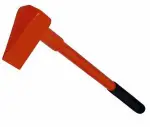
The maul is heavy in comparison to its chopping brothers. With a head weighing from 5 to 12 pounds, the weight distribution is all in the head. It is designed to concentrate force downward onto the piece of wood you are trying to split.
The blade is fat and rounded to help keep it from sticking into a stubborn log. Due to its size and shape, you will split logs much faster with a maul than using other axes.
Pros
- Ideal for splitting logs and firewood
- Backside of the head can be used like a hammer
- Does not become stuck in wood like other axes
Cons
- Heavy
- Too heavy to pack
- Requires a lot of energy to use
SOG Tactical Tomahawk
Tomahawks aren’t your typical axe and nowadays are looked upon more as a survival hatchet or survival axe. Tomahawks resemble a hatchet (camp axe) in size but the axe heads tend to be smaller.
One defining feature of a tomahawk, at least traditional tomahawks, is that the axe head is removable and can be used as a hand tool.
The SOG Tactical Tomahawk is a modern version of a tomahawk and its design is more tactical in nature as it’s meant to be a throwing tool.
The head is made of polished 420 stainless steel, weighs in at 24 ounces, has a glass-reinforced nylon handle, an overall length of 12.5 inches, a checkered hammer surface, and a spike.
Pros
- Extremely lightweight and compact
- Affordable
- Can be used as a hammer
- Spike is versatile and can be used as a glass breaker
- 420 stainless steel is durable and corrosion resistant
- Can be used to chop wood on a small scale
- Can be used to shape wood on a small scale
- Can be thrown
Cons
- Blade length is short
- Designed more as a throwing or breaching tool than an outdoor tool
Machetes
I do not have the space here to list the endless capabilities of the survival machete so I will explain in brief.
A machete isn’t an axe at all, it’s more of a long knife used for light chopping and slashing your way through brush. They are used all over the world by native people for building shelters, killing game, and many other tasks.
Their blades range in length from 12 to 26 inches and have handles made from a variety of materials including wood, plastic, and simply just layers of cloth or string. They are typically full tang and the blade can be made from high-carbon steel, stainless steel, or even an aluminum alloy.
Gerber and Cold Steel make an excellent basic machete that is priced right and that can easily accompany you on several camping trips
Pros
- Lightweight
- Easily packable or worn on the beltline
- Great for clearing brush and light to medium chopping tasks
- Very versatile
- A great tool to have in a survival situation
Cons
- Cannot process wood like the tools listed above
- Not as durable as an axe
Survival Axes, What, Where, When, Why?
What are the best survival axes? Or a survival hatchet?
The word survival gets thrown around a lot as a label but there are products out there deemed a “survival” fill in the blank, due to very specific characteristics.
Usually, these characteristics have to do with the product being extremely compact and lightweight, while also being able to be disassembled or assembled without tools, and the product may have multiple purposes.
For example, a survival bow and arrow is one in which the limbs easily fold in and out, and sometimes even the arrows can be disassembled into two separate pieces. Or a firearm like the Henry AR-7 Survival Rifle in which all the components of the rifle can fit into the stock.
Like the two examples given above, some tools are specifically made, and made well, for survival situations.
However, most hatchets, splitting mauls, and axes do not fall into the category of being a “survival axe.” That is until you find yourself in a survival situation and the axe or chopping tool you have on you becomes a “survival axe,” or “survival hatchet.”
For this reason, some of the best survival axes and choppers out there aren’t actually labeled as a survival axe because they are just simply an axe.
It’s easy to get caught up in the hype but if you see an axe or chopping tool labeled as a “survival axe” or whatever, be cautious before committing any money to it.
This is especially true if it has a lot of extras like it can be used as a can opener, bottle opener, pry bar (you would probably break the handle if you use it like a pry bar, just saying) seatbelt cutter (I don’t think I would want to try and use an axe as a seatbelt cutter, but hey that’s just me) or any of the other many extras that have become standard with “survival” products these days.
A lot of the time, these extras just take away from the quality and functionality of the original product.
Your best bet for a survival axe is to not look at products labeled as survival axes. Do your research and find a company that makes a quality product that best suits your needs, whether that be a hatchet, an axe, a maul, a tomahawk, or a machete. That way, if a survival situation happens, you know you’ll have a tool that you can depend on that will become your survival axe.
FAQs
How do you know what size of axe or chopping tool to get?
What size you choose to carry completely depends on the task you will primarily be using it for.
If you will be doing minimal, lightweight work then a hatchet or camp axe would be good.
For clearing a lot of saplings and trees, go for a forest axe or felling axe.
If you are only going to be splitting already processed logs into firewood, then use a splitting maul.
If you need a tool for a lot of light chopping and for clearing a path, then a machete would be good to have.
What type of axe is best for splitting wood?
A forest axe or felling axe can certainly be used for splitting wood. However, if the wood has already been processed down into manageable sizes, the best tool will be a splitting maul.
Is a wood handle, synthetic, or metal handle better?
The type of handle you choose really comes down to a personal preference more than if one is better than the other. There are three main types of handles, wood, synthetic and metal. Each has its advantages and disadvantages.
A wood handle, like a hickory handle, is more traditional and aesthetically pleasing. Wood handles are prone to chipping or breaking if you miss your target but if the handle breaks, you can reseat a new handle into the axe head fairly easily. If you want to keep the handle in good condition, minimal maintenance, or oiling, will be required.
Synthetic handles require almost no maintenance, are lightweight, and are more durable when it comes to wood striking the handle. However, if the handle breaks, replacing it is more tedious and time-consuming.
Metal handles are going to be quite strong but will add more weight and will require minimal maintenance to prevent rusting. Also, since the axe head and handle are one piece, if the handle breaks, there isn’t a way to quickly restore it.
What is a double-bit axe and should I get one?
A traditional axe has one cutting edge whereas a double-bit axe has cutting surfaces on both sides of the axe head.
One side can be kept sharp for use in cutting and chopping wood while the other side can be kept duller and used more for splitting wood. Or, both sides can be kept sharp which gives you more time to cut and chop before having to stop and resharpen.
A double-bit axe is pretty much like having two axes in one and they can be quite useful tools. Whether or not you need one is debatable and comes down to personal preference and how wood you plan on processing.
How do you sharpen an axe?
Sharpening an axe head will take a little bit of time but the overall process is simple.
While a vice or clamp is not required, having a way to secure the axe head will make sharpening much easier and safer.
If it’s needed, the first step is to use a metal file to reshape the cutting edge. This is done by finding the angle you want the cutting edge to be and removing metal by running the file in one direction across the surface.
After using a file, a sharpening stone should be used to smooth out the cutting surface. A circular sharpening stone called a puck is much easier to use on an axe than a rectangular sharpening stone.
At this point, you could stop, or you can use fine-grit sandpaper or a leather strop to further smooth and deburr the cutting edge. This will give you a very sharp blade.
How do I maintain my axe?
Other than sharpening, the axe head should be wiped down after use and oiled to prevent rusting. An axe with a metal handle should also be wiped down and oiled after use. A wood handle should be oiled a few times a year, but it may need more or less depending on its condition.
What extra tools should I carry along with my axe?
If you plan on being in the field for an extended period, it’s a good idea to carry a metal file and a sharpening stone to keep the axe sharp. A sheath or blade covering will also help to protect the edge as well as make transporting the tool safer.
Are cheap axes worth getting?
There are some good-quality axes and chopping tools available that are more affordable than others. However, cheap tools are just that, cheap. Cheap tools, like an axe, won’t last, won’t perform well, and can be dangerous if they are constructed with inferior materials and not put together well.
What axes are made in the USA?
Here are just a few companies that make axes in the USA.
- Council Tool
- Best Made Brand
- Barco Industries Inc.
- Estwing
- Fire Axe Inc.
- Razor Back
- Vaughan
Overall
I would recommend at least a forest axe and perhaps a splitting maul for use around the house, more so if you have a wood stove or fireplace to fuel. Also, when you buy an axe, it doesn’t come sharp.
A mill file and a good sharpening stone should take care of maintaining the edge on all of your outdoor tools. Please use common sense when working with any and all cutting tools.


